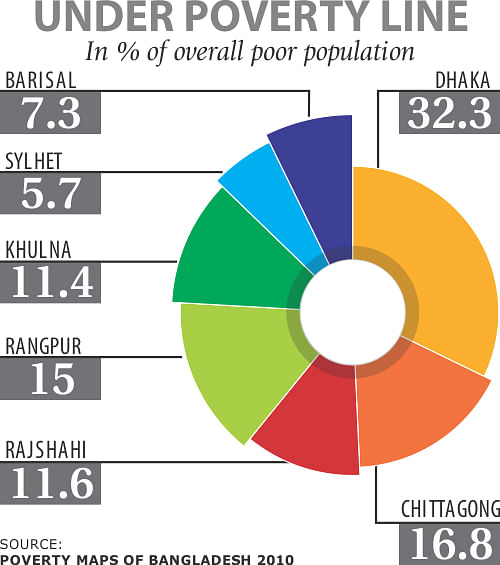Dhaka division home to highest number of poor
Dhaka division home to highest number of poor

Dhaka division has the highest share of the country's poor population, followed by Chittagong, as people from impoverished areas have migrated to these economic hubs in search of employment.
Of a total of 4.94 crore poor people of the country, 1.59 crore or 32.3 percent live in Dhaka and 82.99 lakh in Chittagong. This means nearly half of the country's total poor population live in these two regions.
Interestingly, these two divisions make the highest contributions to the national GDP, with Dhaka metropolis alone contributing 36 percent and Chittagong 11 percent.
These figures were revealed in Poverty Maps of Bangladesh 2010 released yesterday jointly by the Bangladesh Bureau of Statistics (BBS), World Bank and United Nations World Food Programme (WFP).
The poverty maps, the third of their kind since 2004, were unveiled to facilitate policy makers to identify and monitor pockets of affluence and poverty so that they can better plan resource allocations for faster and more effective poverty alleviation.
"The reason for such large concentration of the poor in these two divisions is the concentration of economic activities ... Poor people migrate to these two divisions looking for work," Zahid Hussain, lead economist of WB in Bangladesh, told The Daily Star after the launch of the survey results.
This migration has, however, created congestion, choking up development of the regions, he observed.
"So it is vital to address the reasons of internal migration," he said, suggesting infrastructure development, empowerment of local government and decentralisation of economic activities to discourage the migration trend.
Over the past one and a half decades, Bangladesh has made significant improvement in poverty reduction, thanks to steady economic growth. Currently, 31.5 percent of a total of 15.68 crore people live below the poverty line. The percentage was 48.9 percent in 2000, according to the BBS.
However, the reduction in poverty did not happen evenly in all the regions, mainly because of unequal economic development.
The Poverty Maps 2010 show that the northern division of Rangpur and southern division of Barisal have the highest poverty incidences at 42 percent and 38.3 percent respectively whereas Chittagong and Sylhet have the lowest at 26.1 percent and 25.1 percent. These figures show the number of poor among every 100 people of these regions.
The maps also show that 10 upazilas of Dhaka division have 55 percent or higher poverty rate while it is less than 4 percent in 10 other upazilas.
In the division, Dhaka district has the lowest poverty incidence, while Shariatpur has the highest.
In Chittagong division, 50 percent or higher poverty rate was found in six upazilas whereas the incidence was below 4 percent in the six others.
While Sylhet is amongst the country's most well-off regions, over 50 percent of the population of Gowainghat upazila live in poverty. Similarly, three upazilas in Khulna division have a poverty rate of 50 percent or above.
In Rangpur division, the incidence of poverty in seven upazilas is more than twice the national average (30.7 percent).
Kurigram has been identified as the poorest district in the country with around 63 people among every 100 living in poverty.
Kushtia, on the other hand, is the richest district with 96.4 percent people living above the poverty line.
Of 544 upazilas of the country, 51 upazilas have 50 percent or higher incidence of poverty while 95 have 15 percent or less.
Poverty appears, according to the maps, to be high in chronic disaster-prone areas, such as the districts along the Jamuna river where communities are repeatedly affected by river erosion and flooding, and in the south-west, which is prone to cyclones, tidal surges, salt water intrusion and water-logging.
Salman Zaidi, another lead economist of WB in Bangladesh, said the poverty maps would be helpful in identifying key impediments and odds that poor people face.
The WFP has worked with the government in using the maps -- often in conjunction with other variables -- for targeting of women for Vulnerable Group Development programmes and for targeting areas for school feeding programmes, said WFP Representative in Bangladesh Christa Rader.
At the programme, State Minister for Finance and Planning MA Mannan stressed the need for political stability to expedite the country's development.